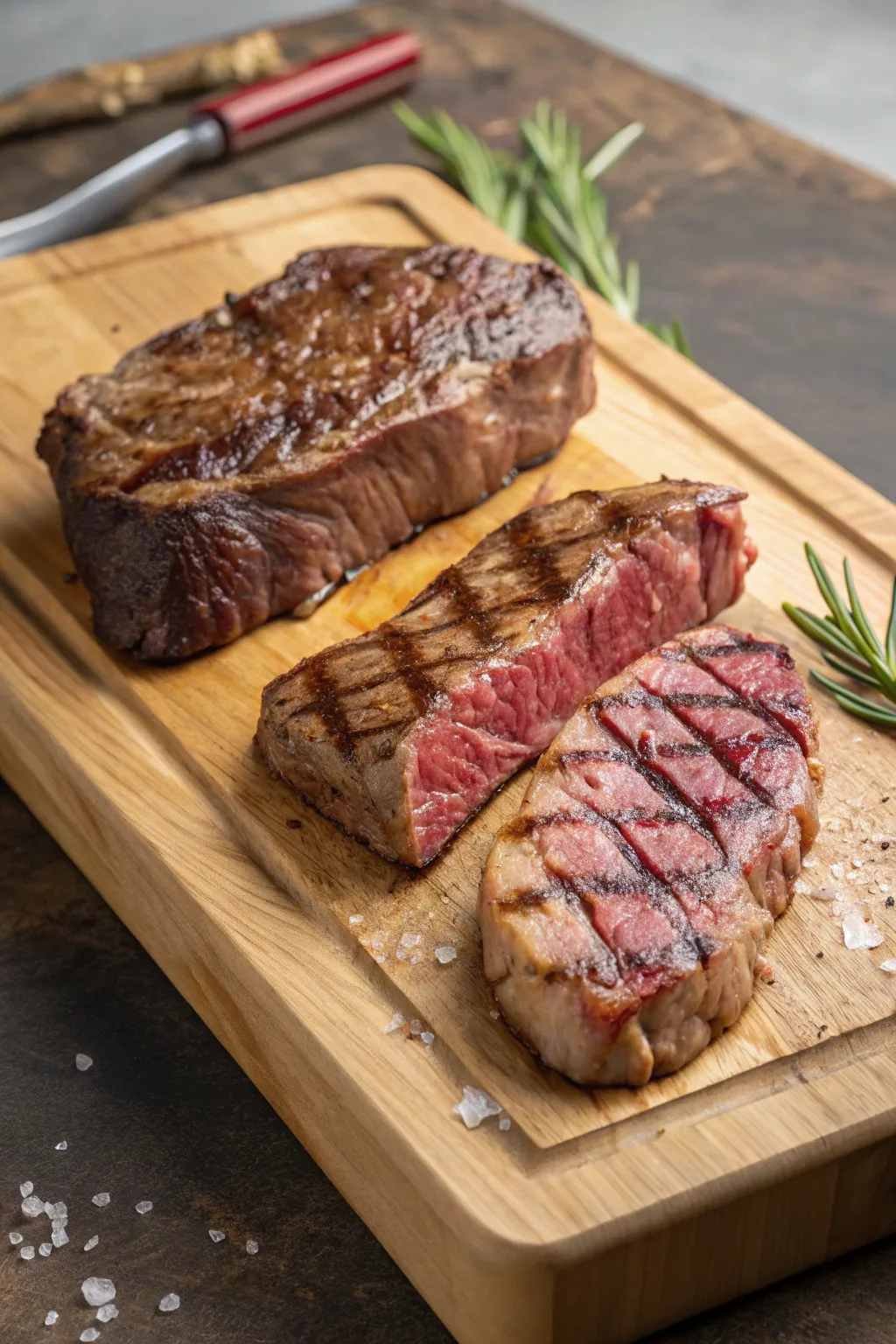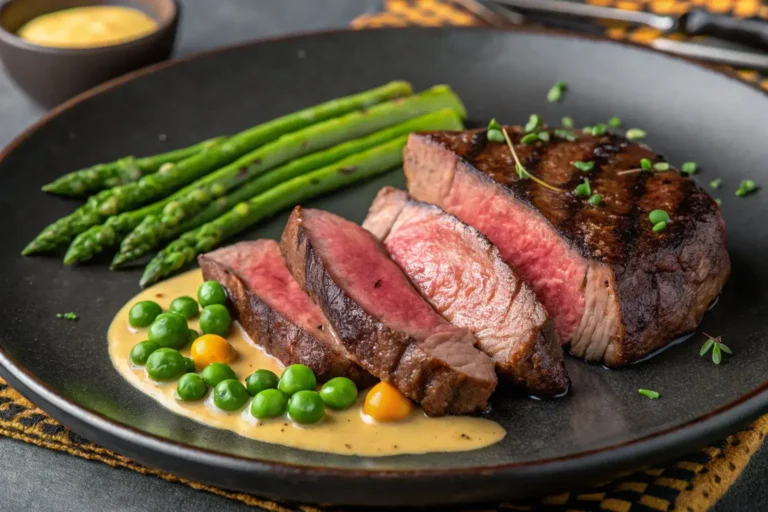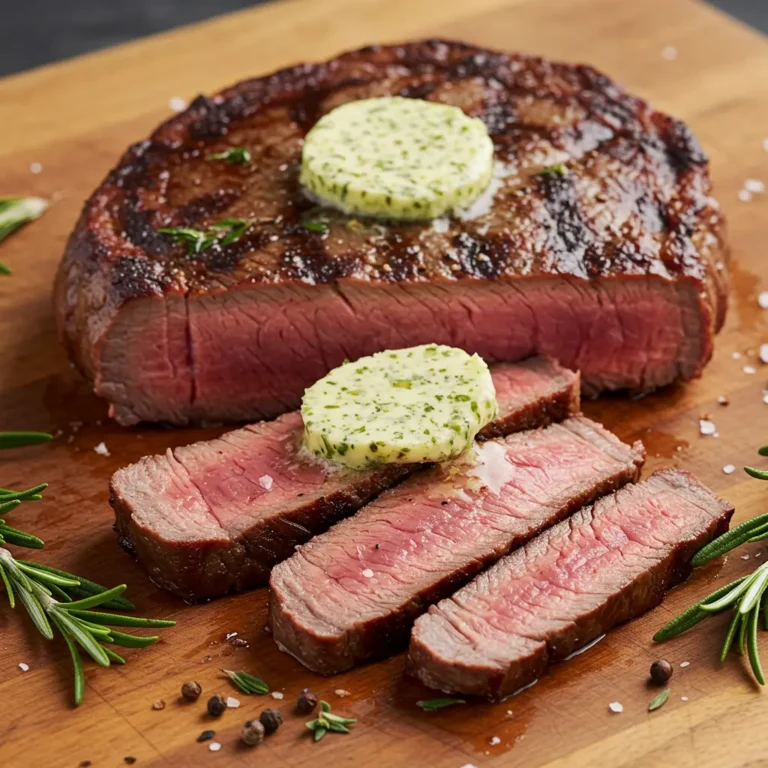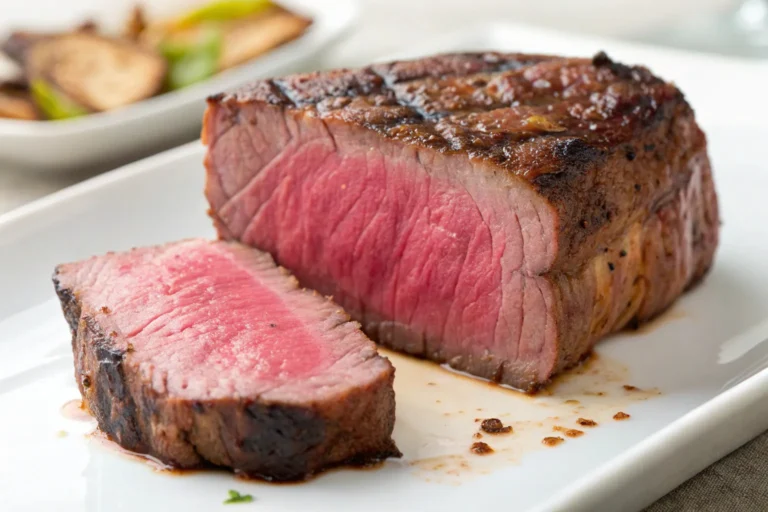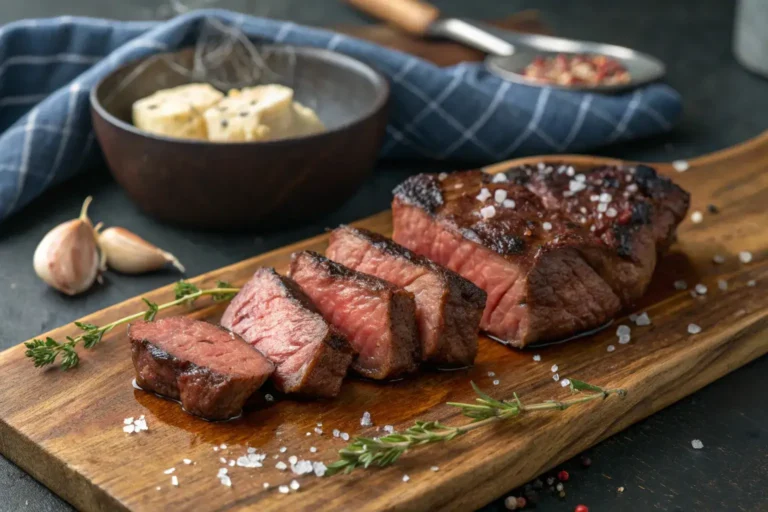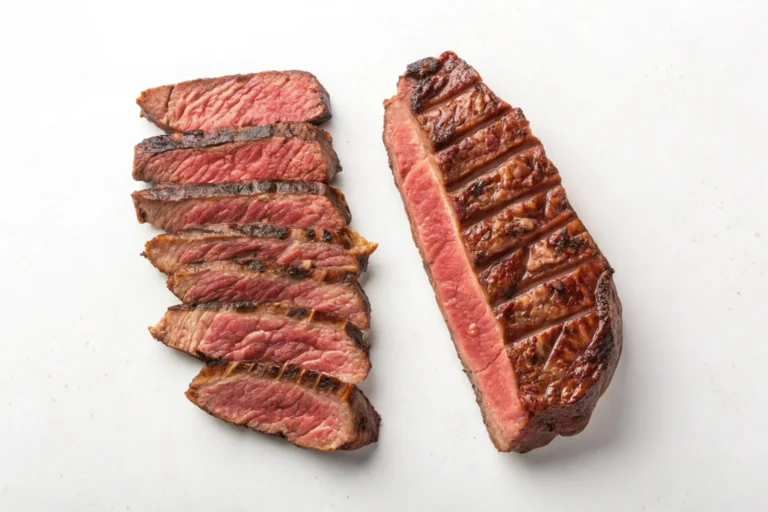New York Strip vs Ribeye: Which Steak is Better?
Are you ready to settle the ultimate steak showdown between the new york strip steak vs ribeye? Meat lovers everywhere debate which cut reigns supreme in the world of premium beef. This comparison will dive deep into the delicious details that make each cut unique.
Steak enthusiasts know that choosing the perfect cut can make or break your dining experience. The battle between the New York Strip and Ribeye isn’t just about taste. It’s about understanding the nuanced characteristics that set these two iconic steaks apart. Your next grilling adventure depends on knowing the subtle differences in this steak comparison.
Table of Contents
Understanding Premium Beef Cuts: New York Strip and Ribeye Basics
Exploring beef cuts is a thrilling journey. Whether you love steaks or want to improve your grilling, knowing about NY strip and ribeye steaks is key. It helps you pick the best cut for your meal.

Beef cuts differ a lot, and their characteristics can change your cooking. NY strip and ribeye steaks are loved for their special qualities. They offer something unique to meat lovers.
Anatomical Location on the Cow
The spot where beef cuts come from affects their taste and feel. Let’s look at where NY strip and ribeye steaks come from:
- NY Strip: From the short loin section of the cow
- Ribeye: From the rib section, close to the spine
- Both are known for being tender and flavorful
USDA Grading Standards
Knowing USDA grading is important when picking beef cuts. The grading system shows the steak’s quality:
- Prime: The highest quality with lots of marbling
- Choice: High-quality meat with less marbling
- Select: Leaner cut with little marbling
Size and Weight Specifications
NY strip and ribeye steaks have different sizes:
- NY Strip: Usually 8-12 ounces, about 1-1.5 inches thick
- Ribeye: Typically 10-16 ounces, a bit thicker
- Thickness affects cooking time and method
Knowing these details helps you choose the right beef cut for your next dish.
Marbling and Fat Content Differences Between These Classic Steaks
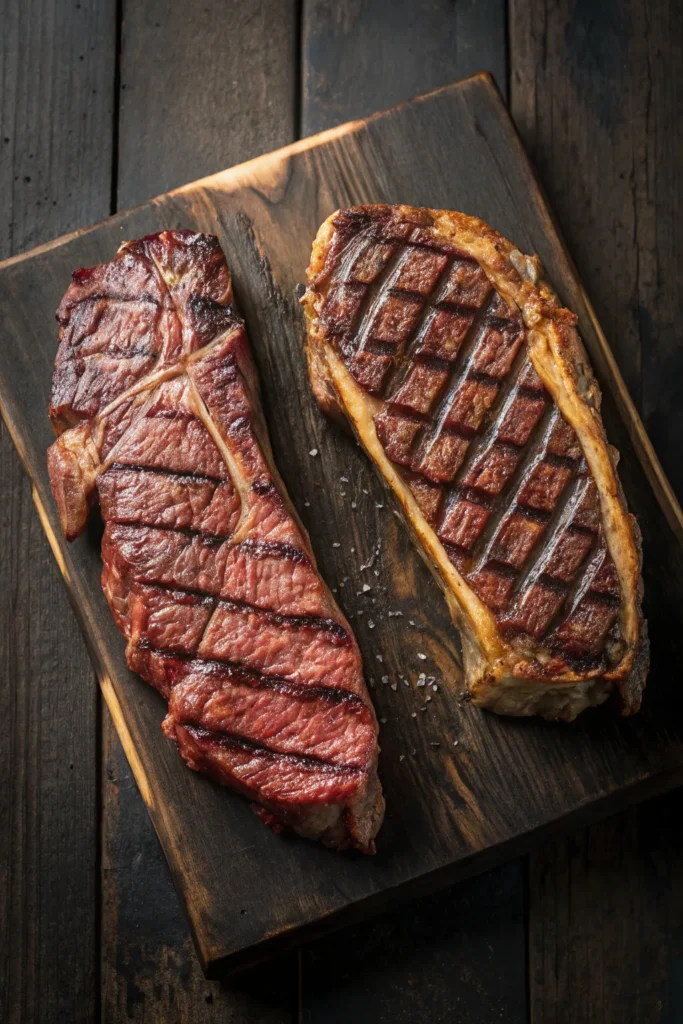
Choosing the right steak can make a big difference in your meal. The fat patterns in beef are key to flavor, tenderness, and quality. They add a lot to how good the steak tastes.
The Ribeye is known for its rich fat. This fat makes the steak juicy and full of flavor. You’ll see white streaks in the meat, which are fat that makes it taste better and stay moist.
- Ribeye typically has higher fat content (around 15-20%)
- New York Strip features more moderate marbling
- Fat distribution varies significantly between cuts
The New York Strip is different. It has less fat than the Ribeye, making it leaner. It’s firmer but not too dry, thanks to its fat. People like it because it’s balanced.
Marbling affects how the steak tastes and how it’s cooked. The Ribeye’s fat makes it easier to cook. But the New York Strip needs careful cooking to stay juicy.
New York Strip Steak vs Ribeye: A Complete Comparison
Exploring premium steaks, it’s key to know the differences between New York strip and ribeye. This guide will help you understand the unique traits of these cuts.
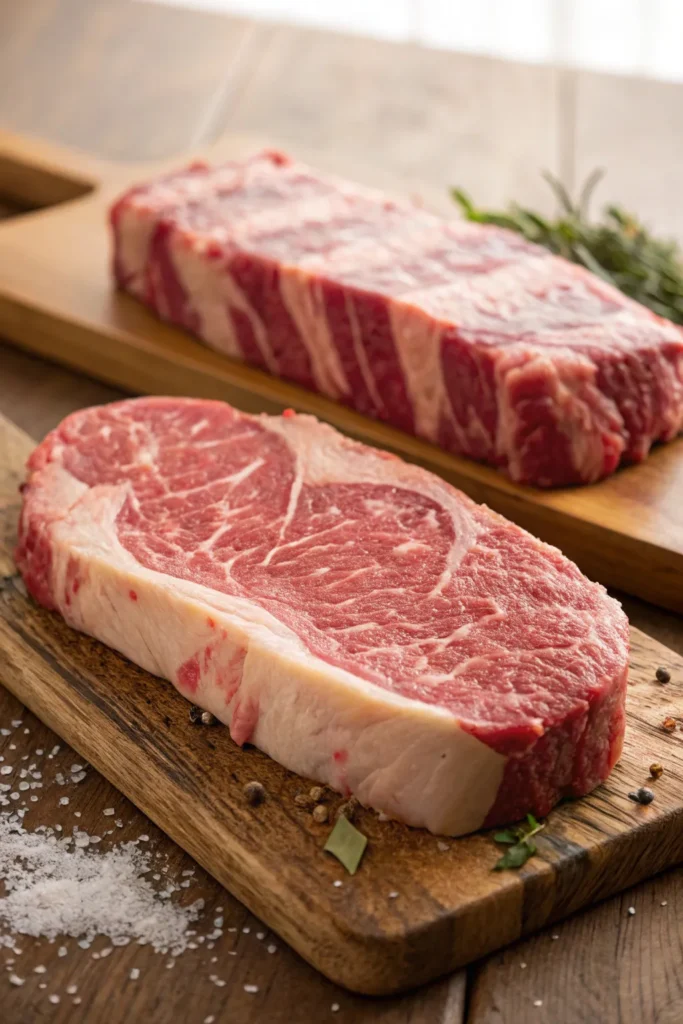
Texture and Tenderness Breakdown
The texture of a New York strip steak and ribeye greatly affects your meal. New York strip has a firmer, chewier texture. Ribeye, with its high fat marbling, is softer and more tender.
- New York strip: Leaner muscle with moderate tenderness
- Ribeye: Rich marbling creating exceptional softness
- Muscle structure influences overall eating quality
Price Point Considerations
The price of New York strip steak and ribeye differs. Ribeye is pricier because of its marbling and tenderness. You’ll likely spend 15-25% more on a premium ribeye than on a New York strip.
Cooking Performance Analysis
Cooking these steaks requires knowing their unique needs. Ribeye’s fat content makes it easier to cook. New York strip needs precise temperature control for tenderness.
- Ribeye: Best for medium-rare to medium cooking
- New York strip: Performs well with direct, high-heat methods
- Both cuts benefit from resting after cooking
Choosing between New York strip and ribeye adds a delightful twist to your meal.
Flavor Profiles and Taste Characteristics
When we compare steaks, the New York Strip and Ribeye stand out. Each offers a unique taste that can change your dining experience.
The New York Strip has a strong, concentrated beef flavor that steak fans adore. It’s leaner, so the taste is straightforward and the texture firm. You’ll taste a clean, beefy flavor that’s perfect for traditional steak lovers.
Ribeye, on the other hand, has a rich, buttery, intense taste that’s luxurious. Its high fat content makes each bite juicy and full of deep flavors.
- New York Strip flavor characteristics:
- Lean and robust beef taste
- Slightly less intense fat flavor
- Firm meat texture
- Ribeye flavor characteristics:
- Rich, buttery taste
- Intense marbling
- Deeply complex flavor profile
How you cook your steak can change its flavor. Grilling brings out the natural beef taste. Pan-searing adds a caramelized outside that boosts the steak’s flavors.
For More inspiration check out our Steak collection
Best Cooking Methods for Each Cut
Grilling steaks well means knowing the special traits of New York Strip and Ribeye. Each steak needs its own cooking method to bring out the best. How you cook it affects its taste, softness, and how enjoyable it is to eat.
Before grilling, get your steak to room temperature and dry it with paper towels. Season it well with kosher salt and fresh pepper. Choose a grill that can get hot, around 450-500°F, for great sear marks and juicy meat.
Recommended Grilling Techniques
Ribeye steaks, with their extra fat, are perfect for direct high-heat grilling. Use a two-zone fire to sear for 3-4 minutes on each side, then finish in the cooler side. New York Strip steaks, being leaner, need a bit less time to cook.
Pan-Searing and Oven-Finishing Tips
For pan-searing, a cast-iron skillet is best for even heat. Sear each side for 2-3 minutes, then finish in a 400°F oven. Steak doneness ranges from rare to well-done. Use a meat thermometer for the right temperature. For medium-rare, aim for 135°F.
Temperature and Doneness Guidelines
Knowing your steak’s doneness is key. Rare is 125°F, medium-rare 135°F, medium 145°F, medium-well 150°F, and well-done 160°F. Always let your steak rest 5-10 minutes after cooking. This lets the juices spread, making it more flavorful and tender.
FAQ
What’s the main difference between New York Strip and Ribeye steaks?
New York Strip and Ribeye steaks differ in marbling and fat content. Ribeye has more fat, making it taste richer. New York Strip is leaner, with a firmer texture and beefier flavor.
Which steak is more tender?
Ribeye is generally more tender than New York Strip. It’s from the rib section, which is less active. This makes it softer than the New York Strip, which is from the short loin.
Are Ribeye steaks more expensive than New York Strip?
Yes, Ribeye steaks are pricier. They have more fat, which adds to their flavor and tenderness. This makes them more expensive than New York Strip.
What’s the best cooking method for these steaks?
Both steaks are great grilled or pan-seared. Ribeye works well with high heat to melt its fat. New York Strip is perfect for grilling or cooking in a cast-iron pan. Cook them to medium-rare for the best taste and tenderness.
Which steak is better for health-conscious eaters?
New York Strip is better for those watching fat. It’s leaner than Ribeye, with less fat. This makes it a healthier choice without sacrificing flavor.
Can I substitute one steak for the other in recipes?
You can substitute them, but each steak is unique. Ribeye’s fat content changes cooking times. Adjust your cooking methods for the best results.
What USDA grade should I look for when buying these steaks?
Choose USDA Prime or Choice for quality. Prime has more marbling, while Choice is more affordable. Both ensure a delicious and tender steak.
How do I know which steak to choose for my preferences?
Think about your taste and cooking style. If you like rich flavor, choose Ribeye. For a leaner cut, go with New York Strip. It’s all about what you prefer.
Did this recipe work for you? We’d love to hear how it turned out!
There are no reviews yet. Be the first one to write one.

